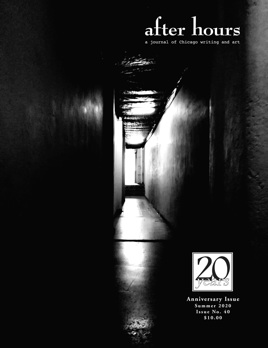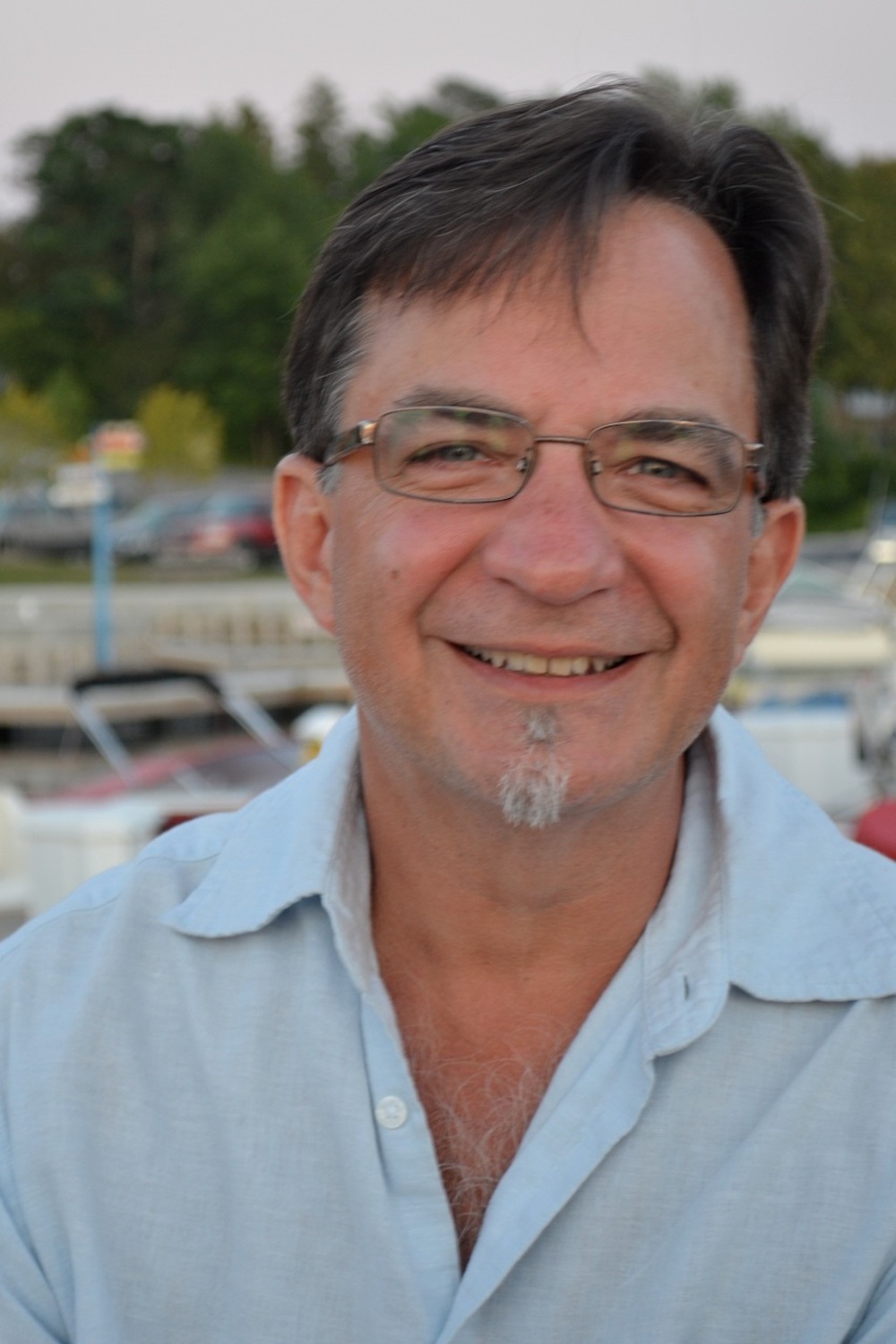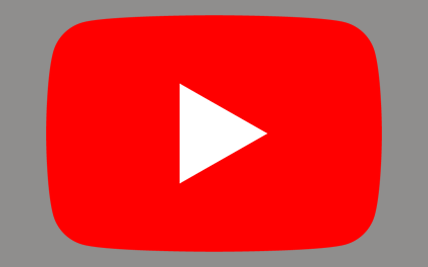An Interview with Publisher and Poet Al DeGenova
Monday, August 17, 2020
By Donald G. Evans
 Al DeGenova writes poetry in a shed he built himself (“every nail and screw”), out back of his second home in Sturgeon Bay, Wisconsin, where he has long been associated with the Clearing Folk School. Al fell in love with Door County even earlier than that first workshop with Norbert Blei nearly a quarter century ago—he and his family used to travel each Easter to Door County starting around 1987. Now that Al teaches Norb’s old workshop and has a house there, he is able to maintain a strong connection to that world while mostly inhabiting the world in which he grew up and grew (somewhat) old: Chicago. At home, in Elmwood Park, it’s the bedroom office (and before that a dusty corner in his Oak Park home’s basement) where he does work of another kind, that of producing one of Chicago’s finest and longest running literary journals, After Hours, a publication that focuses on our local writers.
Al DeGenova writes poetry in a shed he built himself (“every nail and screw”), out back of his second home in Sturgeon Bay, Wisconsin, where he has long been associated with the Clearing Folk School. Al fell in love with Door County even earlier than that first workshop with Norbert Blei nearly a quarter century ago—he and his family used to travel each Easter to Door County starting around 1987. Now that Al teaches Norb’s old workshop and has a house there, he is able to maintain a strong connection to that world while mostly inhabiting the world in which he grew up and grew (somewhat) old: Chicago. At home, in Elmwood Park, it’s the bedroom office (and before that a dusty corner in his Oak Park home’s basement) where he does work of another kind, that of producing one of Chicago’s finest and longest running literary journals, After Hours, a publication that focuses on our local writers.
Or at least, Al does that in his spare time. Recently retired from a decades-long career in corporate marketing, Al now builds fences, puts up drywall, tutors high school kids in writing, plays saxophone at local gigs (sometimes with his professional musician son, Cole) all the while producing a world-class literary journal, not to mention world class poetry. His fifth collection of poetry, Black Pearl, was published in 2016.
After Hours, which Al co-edits with outstanding woman-of-letters and photographer Pat Hertel, celebrates its 20th anniversary this year. Two decades is a remarkable achievement, I don’t care what the endeavor: marriage, a job, still being able to fit into that Journey t-shirt you got at Alpine Valley. But it’s particularly remarkable for a publication that, by its very nature, is unprofitable and largely ignored, if not by the most tuned-in literary aficionados for sure by pop culture at large. Simply put: a literary journal, today, yesterday, probably tomorrow, appeals to a small audience. But for that small audience, it is everything: a chance to be read, a springboard to greater things, a way to build community, a crib sheet on worthwhile authors and visual artists, a gesture toward inclusivity in a world that often does not have the time or space to consider new voices.
It’s not easy. Anybody who’s flirted with publishing knows that what seems fairly straightforward is in fact grueling. It takes time, incredible skill, patience, intelligence, and a vision. After all, what we’re talking about here is running a small business while also fulfilling an artistic mission. So many delicate exchanges with artists. So many difficult decisions about what stays and what goes. So many hours making the various parts sync with one another, and then carefully scrubbing the content of any and all cosmetic errors. Paying for it all.
While it’s difficult to characterize the journal—over the years and decades a wide variety of styles and sensibilities have found their way into the pages—it surely reflects Al’s own personality, which I find to possess so much of Chicago’s penchant, at least in cultural circles, toward curiosity, kindness, humility, and a do-it-yourself spirit. Al perpetually reads books and listens to music. He and his wife Eden met through a band that played corporate gigs and weddings every weekend for a decade. When he lived in Lincoln Park, Al used to walk over to Kingston Mines daily to sit in with the musicians there. He has played in blues bands and performed with notables such as Lefty Diz and Sugar Blues. He and Eden only stopped playing regularly when their second son, Max, was born.
Keep in mind, he did all this while holding down a very demanding day job, in which he wrote every stich of content (brochures, direct sales, advertisements, and so forth) for a German faucet company.
Al shrugs off these accomplishments. The Director of Marketing Communications says, “I would try to romance faucets, which essentially turn water off and turn water on.” This is what I mean about the Chicago spirit Al embodies—he’s enthusiastic, confident, and passionate about all he does while not being the least bit impressed with himself.
I’ve been a friend and admirer of Al’s for close to a decade now. After Hours will launch its 40th issue, here in its 20th year, with a YouTube Live reading this Thursday, August 20, beginning at seven p.m. Featured readers will be contributors David Mathews and Erin Roux (along with myself), with a really high-level lineup of open mic readers to follow.
I had the honor to discuss with Al (over phone and email) a little bit about his life and his journal. The interview has been edited for clarity.
DGE: When did After Hours publish its first edition? How many editions have you put out over the past twenty years?
AD: Our first issue was launched at the June 2000 Printers Row Lit Fest. We’ve published 40 issues since then. Two issues per year for the most part. We did two double issues in years where two separate issues were not possible for different reasons. You can see our archive of covers online which also has the feature in each issue listed as well as links to the table of contents for each issue.
DGE: What made you decide to found the journal?
AD: A couple of reasons actually. First, I was very active at that time (late ‘90s) as a performance poet and doing readings all over town at cafes/bars. I was running into a lot of really fine writers who were not getting published or didn’t think they could get published. Second, myself and a number of writer friends were consistently getting rejected by journals on the “other coasts” and I thought there was some kind of prejudice against Midwestern/Chicago writers…ya know, not as good as New Yorkers or SanFranciscans. (Not to say that my poetry at that time was on a par with some of the big national journals.) Third, Poetry magazine never published Chicagoans. Lastly, but not least of all, I had edited my college lit journal The Oyez Review (late ‘70s) with Pat Hertel. I really enjoyed that experience. When I decided to launch the magazine, Pat was who I called on to help. She continues as my co-editor.
All these things put together made me feel that I could create a journal of exclusively Chicago voices that would create a spotlight for Chicago writers at the turn of the 21st century. With 20 years under our belt now, I do believe we have quite an archive of early 21stcentury Chicago writers. Not that we have published everyone of note, but a lot of the people we’ve published would have been lost to the future if not for being included in the After Hours archive.
DGE: Why did you call it After Hours?
AD: I’ve always been a film noir, late night kind of person. He says tongue-in-cheek. Another reason is that I always have had a day gig so I put the magazine together “after hours.” But the real reason is that Charlie Rossiter and I hosted a monthly poetry/music event at the Buzz Café for the whole year of 1999. It would happen on a Saturday night after the Buzz closed and we called the series After Hours at the Buzz. When Charlie and I realized that we couldn’t grow the audience, we decided to end the series. I asked Charlie if I could use our name, having already begun marketing it, and there it was…After Hours magazine.
DGE: The emphasis is on Chicago writers. What, specifically, do you look for, or not?
AD: We simply look for good, fresh well-crafted writing by people who have some connection to the city of Chicago, metro Chicago, or Chicago ex-pats. This has over the years included people passing through such as Diane DiPrima who was doing a residency at Columbia College for a few months.
But good writing needs some qualification. I make no excuse; our editorial tastes and decisions are completely subjective. Our editorial flavor has been very consistent over the years because it has always been the same editors. And over the years, as submissions have become better, we have also been able to publish what would be considered work of higher “craft.”
But I like writing that “sounds” like Chicago. A little husky, without unnecessary adornments. Honest writing that doesn’t pull punches, that lets emotions live. My editorial tastes run in tandem to Allen Ginsberg who said,“We eat reality sandwiches. But allegories are so much lettuce. Don’t hide the madness.”
DGE: How many writers do you think you’ve published over two decades? Can you give me a list of the first-team all-stars?
AD: We’ve published over 400 writers and photographers/artists over 40 issues. We have a number of regular contributors who have been in multiple issues, but we always try to have at least 40-50 percent of an issue be new voices. It’s a little lower with #40 as we wanted to include some of those writers who have also supported us over the years. With the next issue, number 41, we are going to try to have 100 percent new contributors.
You can look at our Featured Writer list in the archive, but Chicago All Stars would include (not all AH features): Marc Smith, Stuart Dybek, David Hernandez, Mark Turcotte, Billy Lombardo, Martha Vertreace-Doody, Quraysh Ali Lansana, Barry Silesky, Rane Arroyo, Marty McConnell, Cin Salach, Tara Betts, Jacob Saenz, Carlos Cumpián, and Donald G. Evans.
DGE: Any you can mention that made their debut in After Hours—or at least were published very early on--whose reputation has grown substantially?
AD: The list of first-time publications in After Hours is pretty long. Who have gone on to bigger careers? (I would never be so bold as to say we launched them). Let’s see…hmm…many people I’ve lost track of so couldn’t say for sure: Donna Vorreyer, Timothy Rey, Emily Rose, Sandra Marchetti, Jennifer Bisbing, Lori Rader-Day...
DGE: How has your decades experience reading and publishing Chicago writers influenced the way you think about our city's literary artists? Any observations about Chicago writers and artists as a group?
AD: I think Chicago writers are among the most dedicated writers that I’ve experienced. They are determined and uncompromising. They also do not fall for artifice and can identify BS instantly. Just like the city itself, Chicago writers are real, what you see is what you get. Chicago writers are also supportive of each other, though also like the city our writers tend to segregate themselves into groups.
When I started the magazine I was looking for the Chicago voice. I wanted it to sound like Nelson Algren or Hemingway or Carl Sandburg, or Marc Smith even. But what I’ve learned is that the Chicago voice is not any one voice, it is as diverse as the city itself. But despite the diversity of backgrounds and experiences, writing styles, aesthetics, education, the Chicago voice is as I’ve described above…big shoulders and big heart. And big shoulders in no way shuts out our women who are often even more powerful with their words than men.
DGE: Twenty years is a long time. I suspect that many people do not realize the kind of heroic effort involved in putting out even a single issue, given what I assume is a modest budget and a limited staff. Can you give us a sense of what goes into the creation of a single journal?
AD: I always use the cliché that it is a labor of love, but it is. I can’t stop. I realize I’m not getting any younger but that also means I am consciously looking for how we set ourselves today to last another 20 years. We’ve always been a hand-to-mouth organization, one issue usually pays for the next and when we run short it comes out of my pocket. Yes, we have a small staff, and no one is paid. The process is pretty straightforward. We receive submissions in a constant stream though they increase as we approach our deadlines. Two editors read everything and separate submissions into individual yes/no/maybe categories. The editors then compare their results, do a bit of arguing, and make final decisions of what will be included in the next issue. Since I have a background in print production, I do the physical layout and handle getting it printed. My co-editor, Pat Hertel, is instrumental in creating the order of the submissions within the book as well as doing the heavy lifting of proof reading. After that it’s the event planning to promote a new issue as well as updating our website, social media, etc. The actual production process can take four to six weeks after we’ve completed the reading.
DGE: What are some of the little details that go into it that most people wouldn’t think about?
AD: There is so much little stuff: you’ve got to keep a database and then follow up with people. You have to drive the journal around to bookstores. You’ve got to go to post office and mail the damn things. There are a lot of steps you don’t even think about.
DGE: How have you been able to sustain this effort for twenty years?
AD: That’s hard to answer. I really enjoy editing, but I believe that what we’ve accomplished cannot be put to rest. I’m hoping that now that I have a bit more time on my hands, I’ll be able to take the magazine to a higher level whatever that means. To be honest, putting out the magazine has become part of the rhythm of my life.
DGE: Did you ever think it was time to stop? If not, what continues to motivate you?
AD: There were periods when finances were a real problem, but contributors and supporters came to our rescue with donations. There were also periods when my day gig was becoming more demanding of my time and brain space. But those were passing problems, I’ve never actually considered stopping, not truly.
DGE: I know After Hours is archived at the Newberry Library. Where else are the historical issues housed? What is the reach of After Hours?
AD: We are also archived at the University of Chicago Library and the University of Wisconsin/Madison. The Chicago Public Library receives each issue but I cannot say for sure what they do with it. The Read-Write Library has an incomplete library at the moment, I have to get them back up to date.
I’d rather not say specifically our reach…in general each issue reaches over 400. Our circulation is primarily based on contributor copies and purchases, a handful of subscribers, Printers Row whenever that will happen again, and very limited book store sales.
DGE: My story set during our current pandemic is included in this current issue. Other than that, tell us a bit about what's in this one? Is every issue a revelation in some way?
AD: Issue #40 includes two features, yours and a photographic feature of the work of Moira Pujols who is the executive director of contratiempo, as well as a real mover in a number of other LatinX literary endeavors. This issue also features the winners of our second annual Mary Blinn Poetry Prize. We also have a number of photographs from Santiago Weksler who is someone that was a past featured artist. We’ve never done a themed issue but each issue tends to find its own ethos. Whether that has to do with current events or just something in the air of our contributors. Your story of course is about the pandemic, but other work in this issue is tending toward overall existential fears. But that is not true of 100 percent of the issue. Because it is our anniversary issue we solicited work from some contributors who have been long time supporters, so this is issue’s feel is somewhat unfocused.
DGE: Pre-pandemic: you've got an issue about to hit the streets--or mailboxes, or stores, or however you get these into people's hands. What does the launch usually look like?
AD: Once the mag is printed we mail to contributors and subscribers, the summer issue is always launched at the Printers Row Lit Fest, both summer and winter issues are promoted with a contributors reading that happens shortly after the printing is complete. We also do email blasts and social media posts with the launch of a new issue.
DGE: Looking forward to next week's YouTube Live release reading....how do you expect the virtual experience to compare to previous live experiences?
AD: I co-host the Traveling Mollys Reading Series with Nina Corwin and we’ve been doing that virtually since May. That has gone well, so I am expecting a decent live audience for the reading but the YouTube recording will stay online so that we can continue to promote viewership.
DGE: The list of your accomplishments, both with the journal and beyond, is long. Can you name for us a few of your proudest moments as the publisher of After Hours?
AD: I think two of the proudest moments were when the Newberry Library and the University of Chicago agreed to archive the magazine. That means so much for all of contributors, readers/researchers in the future will be able to read the work of Chicago writers who may not be as famous as others. Our 20th Anniversary is also a very proud moment.
We’ve had a number of great reading events over the years, can’t even remember all of them myself. But having writers like Stuart Dybek and Mark Turcotte agree to be featured writers were also proud moments. I also remember a reading at Printers Row when Mike Puican was our featured writer; his public respect and admiration for the magazi_--and recognizing the effort it takes to keep it going—was quite humbling.
When we launched the first issue a local writer who was in that issue told us with arrogance and condescension, “if you make three issues, that’s the test, then you’ll be around awhile.” 
The general public is invited to attend the reading live at 7 p.m. this Thursday, August 20. The event will be recorded and remain online for those unable to make it.
The new journal is available for purchase through The After Hours website.
Donald G. Evans is the Founding Executive Director of the Chicago Literary Hall of Fame. He is the author of a novel and short story collection, and editor of an anthology. His personal blog often explores Chicago literature.








